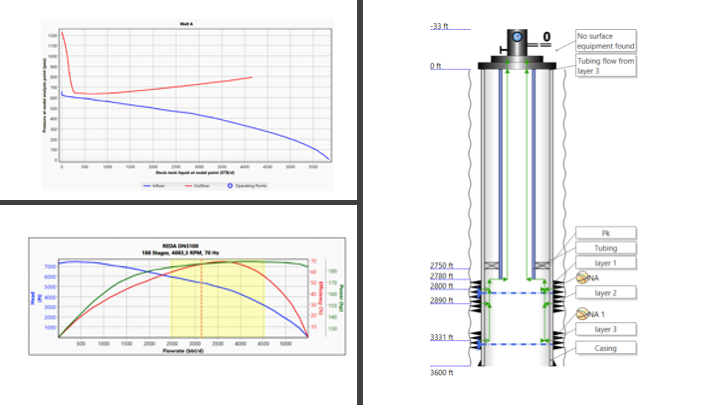Production optimization in Well A and Well B using electric submersible pump (ESP)
Abstract
This research discusses the optimization of production carried out in Well A and Well B. The two Wells are production Well with three production layers (multilayer) that have different characteristics for each layer. Based on the performance evaluation of the production Wells, it’s known that Well A and Well B are no longer able to produce naturally (natural flow). Therefore, it’s necessary to have an artificial lift in order to be able to produce.The artificial lift method used for Well A and Well B is to install an electric submersible pump (ESP), because based on the screening criteria of artificial lift, both Wells can use an electric submersible pump. It’s known that Well A has an absolute open flow (AOF) value of 5840 stb/d and Well B of 3874 stb/d. The production optimization carried out has a production target of 70% of the absolute open flow value. Therefore, the selection of the electric submersible pump for each Well must have an operating flowrate that is in accordance with the production target of the two Wells and must perform a sensitivity test on the selected electric submersible pump to obtain the optimal scenario. So that, the electric submersible pump design for Well A is REDA D4300N with operating frequency of 60 hz and 156 stages, while for Well B is REDA DN3100 with operating frequency of 70 hz and 188 stages.
Full text article
References
Abdelhady, A., Gomaa, S., Ramzi, H., Hisham, H., Galal, A., & Abdelfattah, A. (2020). Electrical submersible pump design in vertical oil wells. Petroleum & Petrochemical Engineering Journal, 4(5), 1–7. https://doi.org/10.23880/ppej-16000237 DOI: https://doi.org/10.23880/ppej-16000237
Amao, M. (2014). Electrical submersible pumping (ESP) systems. https://faculty.ksu.edu.sa/sites/default/files/4-electricalsubmersiblepumps.pdf
Beggs, H. D. (2003). Production optimization using nodal analysis, 2nd edition. Tulsa: OGCI and Petroskills Publications.
Bellarby, J. (2009). Chapter 6 artificial lift. Developments in Petroleum Science, 56, 303–369. https://doi.org/10.1016/S0376-7361(08)00206-9 DOI: https://doi.org/10.1016/S0376-7361(08)00206-9
Brown, E. K. (1984). The technology of artificial lift methods. Tulsa: PennWell Publishing Company.
Cortes, B., Araujo, L. R., & Penido, D. R. R. (2019). Electrical submersible pump system model to assist oil lifting studies. Journal of Petroleum Science and Engineering, 174, 1279–1289. https://doi.org/10.1016/j.petrol.2018.11.055 DOI: https://doi.org/10.1016/j.petrol.2018.11.055
Gunawan, D. (2021). Analisa kontribusi produktivitas formasi pada reservoir berlapis pada lapangan “DG” menggunakan production test [Analysis of formation productivity contribution to layered reservoir in “DG” field using production test] [Master thesis]. Yogyakarta: Universitas Pembangunan Nasional Veteran Yogyakarta.
Guo, B., Lyons, W. C., & Ghalambor, A. (2007). Petroleum production engineering: A computer-assisted approach. Texas: Gulf Professional Publishing. https://doi.org/10.1016/B978-0-7506-8270-1.X5000-2 DOI: https://doi.org/10.1016/B978-075068270-1/50005-0
Kerunwa, A., Obibuike, J. U., Okereke, N. U., Udeagbara, S. G., Nwachukwu, A. N., & Ekwueme, S. T. (2022). Evaluation of electrical submersible pump on field production network optimization in niger delta oilfield. Open Journal of Yangtze Oil and Gas, 7(1), 26–47. https://doi.org/10.4236/ojogas.2022.71003 DOI: https://doi.org/10.4236/ojogas.2022.71003
Mahgoub, I. S., Shahat, M. M., & Fattah, S. A. (2005) Overview of ESP application in western desert of Egypt-strategy for extending lifetime. In The International Petroleum Technology Conference. Doha: IPTC.
https://doi.org/10.2523/IPTC-10142-MS DOI: https://doi.org/10.2523/IPTC-10142-MS
Mohammed, M. S., Al Dabaj, A. A., Lazim, S. A. (2019). Artificial lift design of Mishrif formation in Nasiriyah oil field. Journal of Petroleum Research & Studies, 23(6), 1–21. https://doi.org/10.52716/jprs.v9i2.288 DOI: https://doi.org/10.52716/jprs.v9i2.288
Oliva, G. B., Galvão, H. L., dos Santos, D. P., Silva, R. E., Maitelli, A. L., Costa, R. O., & Maitelli, C. W. (2017). Gas effect in electrical-submersible-pump-system stage-by-stage analysis. SPE Production & Operations, 32(2), 294–304. https://doi.org/10.2118/173969-PA DOI: https://doi.org/10.2118/173969-PA
Stel, H., Sirino, T., Ponce, F. J., Chiva, S., & Morales, R. E. M. (2015). Numerical investigation of the flow in a multistage electric submersible pump. Journal of Petroleum Science and Engineering, 136, 41–54. https://doi.org/10.1016/j.petrol.2015.10.038 DOI: https://doi.org/10.1016/j.petrol.2015.10.038
Sucipto, H., Wiwaha, S. S., & Ridzki, I. (2018). Instalasi ESP (Electric Submersible Pump) sistem tandem pada sumur minyak dengan variable speed drive [Installation of ESP (Electric Submersible Pump) tandem system in oil wells with variable speed drive]. Jurnal Eltek, 16(1), 51. http://dx.doi.org/10.33795/eltek.v16i1.86 DOI: https://doi.org/10.33795/eltek.v16i1.86
Takacs, G. (2009). Electrical submersible pump manual: Design, operations, and maintenance. Burlington: Gulf Professional Publishing. https://doi.org/10.1016/C2017-0-01308-3 DOI: https://doi.org/10.1016/C2017-0-01308-3
Authors
This is an open access journal which means that all content is freely available without charge to the user or his/her institution. The copyright in the text of individual articles (including research articles, opinion articles, and abstracts) is the property of their respective authors, subject to a Creative Commons CC-BY-SA licence granted to all others. JEEE allows the author(s) to hold the copyright without restrictions and allows the author to retain publishing rights without restrictions.




